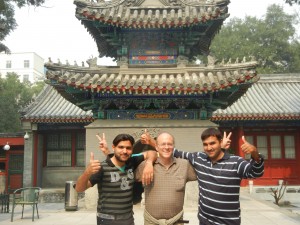Chinese traditions are very deeply rooted, but they’re encountering new perspectives. Beijing is one of the best places to see meetings of the old and new.

I was exploring Beijing’s Cow Street (Niujie) Mosque. It’s Beijing’s largest mosque, and it was begun back in the 10th century. Most of this mosque’s architecture resembles Chinese Daoist and Buddhist temples. So does the Great Mosque in Xi’an. I was admiring Chinese culture’s continuity, and its ability to shape all religions’ art. But then I saw the two men in the above shot.
They were leading a group of 6 young Chinese people. Thinking that they were from India, and having lived there, I asked these two men where they’re from.
They’re from Pakistan, and studying for PHD’s in chemistry. They were showing their fellow students around the mosque. That morning, their cohorts showed up at their dorm door, and asked them to take them there for a tour.
In yesterday’s post on traditional Chinese religion, I stressed continuity. It’s certainly strong. But as more people from around the world study and work in China, perspectives will open up more.
In yesterday’s post, I sharply distinguished traditional Chinese religion from Christianity. But more Chinese people are finding homes in it today. A Chinese pastor I know in San Jose called Luke says that Christianity stresses love. China’s rugged business world, and huge gaps between haves and have-nots have followed the traumas of Mao’s Cultural Revolution and Great Leap Forward, and of WWII–all have eroded faith in society’s harmony. Christianity speaks to some of the people who long for moorings in the modern world.
Chinese traditions are still very strong (we’ll see them in future posts), but how their encounters with the globalized world will shape people’s thought will be one of the next decade’s biggest cultural movements.

Comments on this entry are closed.